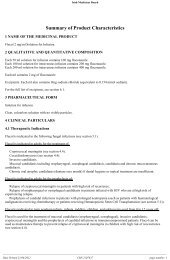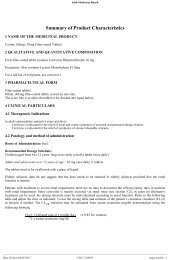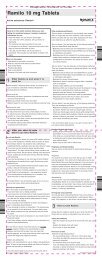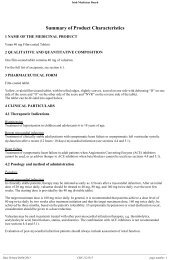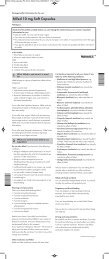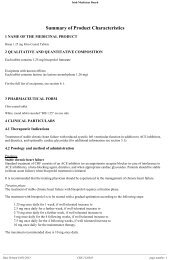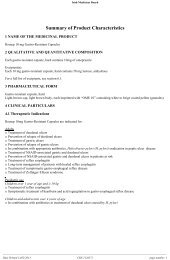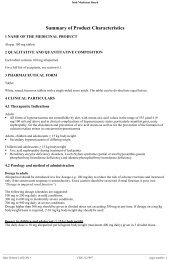Download Quetex 25mg SPC here - Rowex Ltd
Download Quetex 25mg SPC here - Rowex Ltd
Download Quetex 25mg SPC here - Rowex Ltd
You also want an ePaper? Increase the reach of your titles
YUMPU automatically turns print PDFs into web optimized ePapers that Google loves.
Irish Medicines Board<br />
1 NAME OF THE MEDICINAL PRODUCT<br />
<strong>Quetex</strong> <strong>25mg</strong> Film-Coated tablets<br />
Summary of Product Characteristics<br />
2 QUALITATIVE AND QUANTITATIVE COMPOSITION<br />
Each film-coated tablet contains 25 mg quetiapine (as quetiapine fumarate)<br />
Excipient: 16.05 mg lactose (as lactose monohydrate)/film-coated tablet<br />
For a full list of excipients, see section 6.1.<br />
3 PHARMACEUTICAL FORM<br />
Film-coated tablet<br />
<strong>Quetex</strong> <strong>25mg</strong> film-coated tablets:<br />
Salmon-pink coloured, round (6.0 mm diameter) film-coated tablets<br />
4 CLINICAL PARTICULARS<br />
4.1 Therapeutic Indications<br />
Quetiapine is indicated for the treatment of:<br />
schizophrenia<br />
bipolar disorder:<br />
- treatment of moderate to severe manic episodes in bipolar disorder<br />
- treatment of major depressive episodes in bipolar disorder<br />
- prevention of recurrence in patients with bipolar disorder, in patients whose manic or depressive episode<br />
has responded to quetiapine treatment.<br />
4.2 Posology and method of administration<br />
Different dosing schedules exist for each indication. It must t<strong>here</strong>fore be ensured that patients receive clear information<br />
on the appropriate dosage for their condition<br />
Quetiapine can be administered with or without food.<br />
Adults<br />
For the treatment of schizophrenia:<br />
Quetiapine should be administered twice daily.<br />
The total daily dose for the first 4 days of therapy is 50 mg quetiapine (day 1), 100 mg quetiapine (day 2), 200 mg<br />
quetiapine (day 3) and 300 mg quetiapine (day 4).<br />
From day 4 onwards, the dose should be titrated to the usual effective dose range of 300 to 450 mg quetiapine per day.<br />
Depending on the clinical response and tolerability of the individual patient, the dose may be adjusted within the range<br />
of 150 to 750 mg quetiapine per day.<br />
For the treatment of moderate to severe manic episodes in bipolar disorder:<br />
Quetiapine should be administered twice daily.<br />
The total daily dose for the first four days of therapy is 100 mg quetiapine (day 1), 200 mg quetiapine (day 2), 300 mg<br />
quetiapine (day 3) and 400 mg quetiapine (day 4). Further dosage adjustments up to 800 mg quetiapine per day by day<br />
6 should be in increments of no greater than 200 mg quetiapine per day.<br />
______________________________________________________________________________________________________________________<br />
Date Printed 11/02/2013 CRN 2120799 page number: 1
Irish Medicines Board<br />
The dose may be adjusted depending on clinical response and tolerability of the individual patient, within the range of<br />
200 to 800 mg quetiapine per day. The usual effective dose is in the range of 400 to 800 mg quetiapine per day.<br />
For the treatment of depressive episodes in bipolar disorder:<br />
Quetiapine should be administered once daily at bedtime.<br />
The total daily dose for the first four days of therapy is 50 mg quetiapine (day 1), 100 mg quetiapine (day 2), 200 mg<br />
quetiapine (day 3) and 300 mg quetiapine (day 4). The recommended daily dose is 300 mg quetiapine.<br />
In clinical trials, no additional benefit was seen in the 600 mg group compared to the 300 mg group (see section 5.1).<br />
Individual patients may benefit from a 600 mg dose. Doses greater than 300 mg quetiapine should be initiated by<br />
physicians experienced in treating bipolar disorder. In individual patients, in the event of tolerance concerns, clinical<br />
trials have indicated that dose reduction to a minimum of 200 mg quetiapine could be considered.<br />
For preventing recurrence in bipolar disorder:<br />
For preventing recurrence of manic, mixed or depressive episodes in bipolar disorder, patients who have responded to<br />
quetiapine for acute treatment of bipolar disorder should continue therapy at the same dose. The dose may be adjusted<br />
depending on clinical response and tolerability of the individual patient, within the range of 300 to 800 mg quetiapine<br />
per day administered twice daily. It is important that the lowest effective dose is used for maintenance therapy.<br />
Elderly patients over 65 years<br />
As with other antipsychotics, quetiapine should be used with caution in the elderly, especially during the initial dosing<br />
period. The rate of dose titration may need to be slower, and the daily therapeutic dose lower, than that used in younger<br />
patients, depending on the clinical response and tolerability of the individual patient. The mean plasma clearance of<br />
quetiapine was reduced by 30 - 50% in elderly subjects when compared to younger patients.<br />
Efficacy and safety has not been evaluated in patients over 65 years with depressive episodes in the framework of<br />
bipolar disorder.<br />
Children and adolescents under 18 years<br />
Quetiapine is not recommended for use in children and adolescents below 18 years of age, due to a lack of data to<br />
support use in this age group. The available evidence from placebo-controlled clinical trials is presented in sections 4.4,<br />
4.8, 5.1 and 5.2.<br />
Renal impairment<br />
Dosage adjustment is not necessary in patients with renal impairment.<br />
Hepatic impairment<br />
Quetiapine is extensively metabolised by the liver. T<strong>here</strong>fore, quetiapine should be used with caution in patients with<br />
known hepatic impairment, especially during the initial dosing period. Patients with known hepatic impairment should<br />
be started with 25 mg quetiapine per day. The dosage should be increased daily with increments of 25 - 50 mg<br />
quetiapine per day until an effective dosage, depending on the clinical response and tolerability of the individual<br />
patient.<br />
Note<br />
For doses not realizable/practicable with these medicinal products other quetiapine containing products with higher<br />
strengths are available.<br />
4.3 Contraindications<br />
Hypersensitivity to the active substance or to any of the excipients of this medicinal product.<br />
Concomitant administration of cytochrome-P450 3A4- inhibitors such as HIV protease inhibitors, azole-antifungal<br />
agents, erythromycin, clarithromycin and nefazodone, is contraindicated (see also section 4.5).<br />
______________________________________________________________________________________________________________________<br />
Date Printed 11/02/2013 CRN 2120799 page number: 2
Irish Medicines Board<br />
4.4 Special warnings and precautions for use<br />
As quetiapine has several indications, the safety profile should be considered with respect to the individual patient’s<br />
diagnosis and the dose being administered.<br />
Children and adolescents (10 to 17 years of age)<br />
Quetiapine is not recommended for use in children and adolescents below 18 years of age, due to a lack of data to<br />
support use in this age group. Clinical trials have shown that in addition to the known safety profile identified in adults<br />
(see section 4.8), certain adverse events occurred at a higher frequency in children and adolescents compared to adults<br />
(increased appetite, elevations in serum prolactin and extrapyramidal symptoms) and one was identified that has not<br />
been previously seen in adult studies (increases in blood pressure). Changes in thyroid function tests have also been<br />
observed in children and adolescents.<br />
Furthermore, the long-term safety implications of treatment with quetiapine on growth and maturation have not been<br />
studied beyond 26 weeks. Long-term implications for cognitive and behavioural development are not known.<br />
In placebo-controlled clinical trials with children and adolescent patients treated with quetiapine, quetiapine was<br />
associated with an increased incidence of extrapyramidal symptoms (EPS) compared to placebo in patients treated for<br />
schizophrenia and bipolar mania (see section 4.8).<br />
Suicide/suicidal thoughts or clinical worsening<br />
Depression in bipolar disorder is associated with an increased risk of suicidal thoughts, self-harm and suicide (suiciderelated<br />
events). This risk persists until significant remission occurs. As improvement may not occur during the first few<br />
weeks or more of treatment, patients should be closely monitored until such improvement occurs. It is general clinical<br />
experience that the risk of suicide may increase in the early stages of recovery.<br />
In addition, physicians should consider the potential risk of suicide-related events after abrupt cessation of quetiapine<br />
treatment, due to the known risk factors for the disease being treated.<br />
Other psychiatric conditions for which quetiapine is prescribed can also be associated with an increased risk of suicide<br />
related events. In addition, these conditions may be co-morbid with major depressive episodes. The same precautions<br />
observed when treating patients with major depressive episodes should t<strong>here</strong>fore be observed when treating patients<br />
with other psychiatric disorders.<br />
Patients with a history of suicide related events, or those exhibiting a significant degree of suicidal ideation prior to<br />
commencement of treatment are known to be at greater risk of suicidal thoughts or suicide attempts, and should receive<br />
careful monitoring during treatment. A meta-analysis of placebo controlled clinical trials of antidepressant drugs in<br />
adult patients with psychiatric disorders showed an increased risk of suicidal behaviour with antidepressants compared<br />
to placebo in patients less than 25 years old.<br />
Close supervision of patients and in particular those at high risk should accompany drug therapy especially in early<br />
treatment and following dose changes. Patients (and caregivers of patients) should be alerted about the need to monitor<br />
for any clinical worsening, suicidal behaviour or thoughts and unusual changes in behaviour and to seek medical advice<br />
immediately if these symptoms present.<br />
In short-term placebo controlled clinical studies of patients with major depressive episodes in bipolar disorder an<br />
increased risk of suicide-related events was observed in young adult patients (younger than 25 years of age) who were<br />
treated with quetiapine as compared to those treated with placebo (3.0% vs. 0%, respectively).<br />
Extrapyramidal Symptoms<br />
In placebo controlled clinical trials of adult patients quetiapine was associated with an increased incidence of<br />
extrapyramidal symptoms (EPS) compared to placebo in patients treated for major depressive episodes in bipolar<br />
disorder (see section 4.8 and 5.1).<br />
The use of quetiapine has been associated with the development of akathisia, characterised by a subjectively unpleasant<br />
or distressing restlessness and need to move often accompanied by an inability to sit or stand still. This is most likely to<br />
______________________________________________________________________________________________________________________<br />
Date Printed 11/02/2013 CRN 2120799 page number: 3
Irish Medicines Board<br />
occur within the first few weeks of treatment. In patients who develop these symptoms, increasing the dose may be<br />
detrimental.<br />
Tardive Dyskinesia<br />
If signs and symptoms of tardive dyskinesia appear, dose reduction or discontinuation of quetiapine should be<br />
considered. The symptoms of tardive dyskinesia can worsen or even arise after discontinuation of treatment (see<br />
section 4.8).<br />
Somnolence and dizziness<br />
Quetiapine treatment has been associated with somnolence and related symptoms, such as sedation (see section 4.8). In<br />
clinical trials for treatment of patients with bipolar depression, onset was usually within the first 3 days of treatment<br />
and was predominantly of mild to moderate intensity. Bipolar depression patients experiencing somnolence of severe<br />
intensity may require more frequent contact for a minimum of 2 weeks from onset of somnolence, or until symptoms<br />
improve and treatment discontinuation may need to be considered.<br />
Quetiapine treatment has been associated with orthostatic hypotension and related dizziness (see section 4.8) which,<br />
like somnolence has onset usually during the initial dose-titration period. This could increase the occurrence of<br />
accidental injury (fall), especially in the elderly population. T<strong>here</strong>fore, patients should be advised to exercise caution<br />
until they are familiar with the potential effects of the medication<br />
Cardiovascular<br />
Quetiapine should be used with caution in patients with known cardiovascular disease, cerebrovascular disease, or<br />
other conditions predisposing to hypotension. Quetiapine may induce orthostatic hypotension especially during the<br />
initial dose-titration period and t<strong>here</strong>fore dose reduction or more gradual titration should be considered if this occurs. A<br />
slower titration regimen could be considered in patients with underlying cardiovascular disease.<br />
Seizures<br />
In controlled clinical trials t<strong>here</strong> was no difference in the incidence of seizures in patients treated with quetiapine or<br />
placebo. No data is available about the incidence of seizures in patients with a history of seizure disorder. As with other<br />
antipsychotics, caution is recommended when treating patients with a history of seizures (see section 4.8 ).<br />
Neuroleptic Malignant Syndrome<br />
Neuroleptic malignant syndrome has been associated with antipsychotic treatment, including quetiapine (see section<br />
4.8 ). Clinical manifestations include hyperthermia, altered mental status, muscular rigidity, autonomic instability, and<br />
increased creatine phosphokinase. In such an event, quetiapine should be discontinued and appropriate medical<br />
treatment given.<br />
Severe Neutropenia<br />
Severe neutropenia (neutrophil count
Irish Medicines Board<br />
Weight<br />
Weight gain has been reported in patients who have been treated with quetiapine, and should be monitored and<br />
managed as clinically appropriate as in accordance with utilized antipsychotic guidelines (see sections 4.8 and 5.1).<br />
Hyperglycaemia<br />
Hyperglycaemia and/or development or exacerbation of diabetes occasionally associated with ketoacidosis or coma has<br />
been reported rarely, including some fatal cases (see section 4.8). In some cases, a prior increase in body weight has<br />
been reported which may be a predisposing factor. Appropriate clinical monitoring is advisable in accordance with<br />
utilised antipsychotic guidelines. Patients treated with any antipsychotic agent including quetiapine, should be observed<br />
for signs and symptoms of hyperglycaemia, (such as polydipsia, polyuria, polyphagia and weakness) and patients with<br />
diabetes mellitus or with risk factors for diabetes mellitus should be monitored regularly for worsening of glucose<br />
control. Weight should be monitored regularly.<br />
Lipids<br />
Increases in triglycerides, LDL and total cholesterol, and decreases in HDL cholesterol have been observed in clinical<br />
trials with quetiapine (see section 4.8). Lipid changes should be managed as clinically appropriate.<br />
Metabolic Risk<br />
Given the observed changes in weight, blood glucose (see hyperglycemia) and lipids seen in clinical studies, patients<br />
(including those with normal baseline values ) may experience worsening of their metabolic risk profile, which should<br />
be managed as clinically appropriate (see also section 4.8).<br />
QT Prolongation<br />
In clinical trials and use in accordance with the <strong>SPC</strong>, quetiapine was not associated with a persistent increase in<br />
absolute QT intervals. In post-marketing, QT prolongation was reported with quetiapine at the therapeutic doses (see<br />
section 4.8) and in overdose (see section 4.9). As with other antipsychotics, caution should be exercised when<br />
quetiapine is prescribed in patients with cardiovascular disease or family history of QT prolongation. Also caution<br />
should be exercised when quetiapine is prescribed either with medicines known to increase QT interval, or with<br />
concomitant antipsychotics, especially in the elderly, in patients with congenital long QT syndrome, congestive heart<br />
failure, heart hypertrophy, hypokalaemia or hypomagnesaemia (see section 4.5).<br />
Withdrawal<br />
Acute withdrawal symptoms such as insomnia, nausea, headache, diarrhoea, vomiting, dizziness and irritability have<br />
been described after abrupt cessation of quetiapine. Gradual withdrawal over a period of at least one to two weeks is<br />
advisable (see section 4.8).<br />
Elderly patients with dementia-related psychosis<br />
Quetiapine is not approved for the treatment of dementia-related psychosis.<br />
An approximately 3-fold increased risk of cerebrovascular adverse events has been seen in randomised placebo<br />
controlled trials in the dementia population with some atypical antipsychotics. The mechanism for this increased risk is<br />
not known. An increased risk cannot be excluded for other antipsychotics or other patient populations. Quetiapine<br />
should be used with caution in patients with risk factors for stroke.<br />
In a meta-analysis of atypical antipsychotic drugs, it has been reported that elderly patients with dementia-related<br />
psychosis are at an increased risk of death compared to placebo. However in two 10-week placebo-controlled<br />
quetiapine studies in the same patient population (n=710; mean age: 83 years; range: 56-99 years) the incidence of<br />
mortality in quetiapine treated patients was 5.5% versus 3.2% in the placebo group. The patients in these trials died of a<br />
variety of causes that were consistent with expectations for this population. These data do not establish a causal<br />
relationship between quetiapine treatment and death in elderly patients with dementia.<br />
Dysphagia<br />
Dysphagia (see section 4.8) has been reported with quetiapine. Quetiapine should be used with caution in patients at<br />
risk for aspiration pneumonia.<br />
______________________________________________________________________________________________________________________<br />
Date Printed 11/02/2013 CRN 2120799 page number: 5
Irish Medicines Board<br />
Venous Thromboembolism (VTE)<br />
Cases of venous thromboembolism (VTE) have been reported with antipsychotic drugs. Since patients treated with<br />
antipsychotics often present with acquired risk factors for VTE, all possible risk factors for VTE should be identified<br />
before and during treatment with quetiapine and preventive measures undertaken.<br />
Pancreatitis<br />
Pancreatitis has been reported in clinical trials and during post marketing experience. Among post marketing reports,<br />
while not all cases were confounded by risk factors, many patients had factors which are known to be associated with<br />
pancreatitis such as increased triglycerides (see section 4.8), gallstones, and alcohol consumption.<br />
Lactose<br />
<strong>Quetex</strong> 25 mg Film-Coated Tablets contain lactose. Patients with rare <strong>here</strong>ditary problems of galactose intolerance, the<br />
Lapp lactase deficiency or glucose galactose malabsorption should not take this medicine.<br />
Additional information<br />
Quetiapine data in combination with divalproex or lithium in acute moderate to severe manic episodes is limited;<br />
however, combination therapy was well tolerated (see sections 4.8 and 5.1). The data showed an additive effect at week<br />
3.<br />
4.5 Interaction with other medicinal products and other forms of interaction<br />
Given the primary central nervous system effects of quetiapine, quetiapine should be used with caution in combination<br />
with other centrally acting medicinal products and alcohol.<br />
Cytochrome P450 (CYP) 3A4 is the enzyme that is primarily responsible for the cytochrome P450 mediated<br />
metabolism of quetiapine. In an interaction study in healthy volunteers, concomitant administration of quetiapine<br />
(dosage of 25 mg) with ketoconazole, a CYP3A4 inhibitor, caused a 5- to 8-fold increase in the AUC of quetiapine. On<br />
the basis of this, concomitant use of quetiapine with CYP3A4 inhibitors is contraindicated. It is also not recommended<br />
to consume grapefruit juice while on quetiapine therapy.<br />
In a multiple dose trial in patients to assess the pharmacokinetics of quetiapine given before and during treatment with<br />
carbamazepine (a known hepatic enzyme inducer), co-administration of carbamazepine significantly increased the<br />
clearance of quetiapine. This increase in clearance reduced systemic quetiapine exposure (as measured by AUC) to an<br />
average of 13% of the exposure during administration of quetiapine alone; although a greater effect was seen in some<br />
patients. As a consequence of this interaction, lower plasma concentrations can occur, which could affect the efficacy<br />
of quetiapine therapy. Co-administration of quetiapine and phenytoin (another microsomal enzyme inducer) caused a<br />
greatly increased clearance of quetiapine by approx. 450%. In patients receiving a hepatic enzyme inducer, initiation of<br />
quetiapine treatment should only occur if the physician considers that the benefits of quetiapine outweigh the risks of<br />
removing the hepatic enzyme inducer. It is important that any change in the inducer is gradual, and if required, replaced<br />
with a non-inducer (e.g. sodium valproate) (see section 4.4 ).<br />
The pharmacokinetics of quetiapine were not significantly altered by co-administration of the antidepressants<br />
imipramine (a known CYP 2D6 inhibitor) or fluoxetine (a known CYP 3A4 and CYP 2D6 inhibitor).<br />
The pharmacokinetics of quetiapine were not significantly altered by co-administration of the antipsychotics<br />
risperidone or haloperidol. Concomitant use of quetiapine and thioridazine caused an increased clearance of quetiapine<br />
with approx. 70%.<br />
The pharmacokinetics of quetiapine were not altered following co-administration with cimetidine.<br />
The pharmacokinetics of lithium were not altered when co-administered with quetiapine.<br />
The pharmacokinetics of sodium valproate and quetiapine were not altered to a clinically relevant extent when coadministered.<br />
A retrospective study of children and adolescents who received valproate, quetiapine, or both, found a<br />
______________________________________________________________________________________________________________________<br />
Date Printed 11/02/2013 CRN 2120799 page number: 6
Irish Medicines Board<br />
higher incidence of leucopenia and neutropenia in the combination group versus the monotherapy groups.<br />
Formal interaction studies with commonly used cardiovascular medicinal products have not been performed.<br />
Caution should be exercised when quetiapine is used concomitantly with medicinal products known to cause electrolyte<br />
imbalance or to increase QT interval.<br />
T<strong>here</strong> have been reports of false positive results in enzyme immunoassays for methadone and tricyclic antidepressants<br />
in patients who have taken quetiapine. Confirmation of questionable immunoassay screening results by an appropriate<br />
chromatographic technique is recommended.<br />
4.6 Fertility, pregnancy and lactation<br />
The safety and efficacy of quetiapine during human pregnancy have not yet been established. Up to now t<strong>here</strong> are no<br />
indications for harmfulness in animal tests, possible effects on the foetal eye have not been examined, though.<br />
T<strong>here</strong>fore, quetiapine should only be used during pregnancy if the benefits justify the potential risks. Following<br />
pregnancies in which quetiapine was used, neonatal withdrawal symptoms were observed. Neonates exposed to<br />
antipsychotics (including quetiapine) during the third trimester of pregnancy are at risk of adverse reactions including<br />
extrapyramidal and/or withdrawal symptoms that may vary in severity and duration following delivery. T<strong>here</strong> have<br />
been reports of agitation, hypertonia, hypotonia, tremor, somnolence, respiratory distress, or feeding disorder.<br />
Consequently, newborns should be monitored carefully.<br />
T<strong>here</strong> have been published reports of quetiapine excretion into human breast milk, however the degree of excretion was<br />
not consistent. Women who are breast-feeding should t<strong>here</strong>fore be advised to avoid breast-feeding while taking<br />
quetiapine.<br />
4.7 Effects on ability to drive and use machines<br />
Quetiapine has minor or moderate influence on the ability to drive and use machines. Given its primary central nervous<br />
system effects, quetiapine may cause somnolence and dizziness and thus interfere with activities requiring mental<br />
alertness. T<strong>here</strong>fore, patients should be advised not to drive or operate machinery, until individual susceptibility to this<br />
is known.<br />
4.8 Undesirable effects<br />
The most commonly reported Adverse Drug Reactions (ADRs) with quetiapine are somnolence, dizziness, dry mouth,<br />
mild asthenia, constipation, tachycardia, orthostatic hypotension and dyspepsia.<br />
As with other antipsychotics, weight gain, syncope, neuroleptic malignant syndrome, leucopenia, neutropenia and<br />
peripheral oedema have been associated with quetiapine.<br />
The incidences of ADRs associated with quetiapine therapy, are listed below according to the format recommended by<br />
the Council for International Organizations of Medical Sciences (CIOMS III Working Group 1995).<br />
The following frequency estimates are used in assessing adverse events:<br />
Very common:<br />
(≥1/10)<br />
Common: (≥1/100 to
Irish Medicines Board<br />
Uncommon: thrombocytopenia, anaemia, platelet count decreased 14<br />
Rare: agranulocytosis 27<br />
Not known: neutropenia 1<br />
Immune system disorders<br />
Uncommon: hypersensitivity (including allergic skin reactions)<br />
Very rare: anaphylactic reaction 6<br />
Endocrine disorders<br />
Common: hyperprolactinaemia 16 , decreases in total T 4 25 , decreases in free T 4 25 , decreases in total T 3 25 ,<br />
increases in<br />
TSH 25<br />
Uncommon: decreases in free T 3 25 , hypothyroidism 22<br />
Very rare: inappropriate antidiuretic hormone secretion<br />
Metabolism and nutrition disorders<br />
Very common: elevations in serum triglyceride levels 11, 31 , elevations in total cholesterol (predominantly LDL<br />
cholesterol) 12, 31 , decreases in HDL cholesterol 18, 31 , weight gain<br />
9, 31<br />
Common: increased appetite, blood glucose increased to hyperglycaemic levels<br />
7, 31<br />
Uncommon: hyponatraemia 20 , diabetes mellitus<br />
1, 5, 6<br />
Rare: metabolic syndrome 30<br />
Psychiatric disorders<br />
Common: abnormal dreams and nightmares, suicidal ideation and suicidal behaviour 21<br />
Rare: somnambulism and related reactions such as sleep talking and sleep related eating disorder<br />
Nervous system disorders<br />
Very common: dizziness 4, 17 , somnolence 2, 17 , headache<br />
Common: syncope 4, 17 ,, extrapyramidal symptoms 1, 22 , dysarthria<br />
Uncommon: seizure 1 , restless legs syndrome, tardive dyskinesia 1, 6<br />
Eye disorders<br />
Common: vision blurred<br />
Cardiac disorders<br />
Common: tachycardia 4 , palpitations 24<br />
Uncommon: QT prolongation<br />
1, 13, 19<br />
Vascular disorders<br />
Common: orthostatic hypotension<br />
Rare: venous thromboembolism 1<br />
4, 17<br />
Respiratory, thoracic and mediastinal disorders<br />
Common: rhinitis, dyspnoea 24<br />
Gastrointestinal disorders<br />
Very common: dry mouth<br />
Common: constipation, dyspepsia, vomiting 26<br />
Uncommon: dysphagia 8<br />
Rare: pancreatitis 1<br />
______________________________________________________________________________________________________________________<br />
Date Printed 11/02/2013 CRN 2120799 page number: 8
Irish Medicines Board<br />
Hepatobiliary disorders<br />
Common: elevations in serum transaminases (ALT, AST) 3 , elevations in gamma-GT levels 3<br />
Rare: jaundice 6 , hepatitis<br />
Skin and subcutaneous tissue disorders<br />
Very rare: angioedema 6 , Stevens-Johnson syndrome 6<br />
Not known: toxic epidermal necrolysis, erythema multiforme<br />
Musculoskeletal and connective tissue disorders<br />
Very rare: rhabdomyolysis<br />
Pregnancy, puerperium and perinatal conditions<br />
Not known: drug withdrawal syndrome neonatal 32<br />
Reproductive system and breast disorders<br />
Uncommon: sexual dysfunction<br />
Rare: priapism, galactorrhoea, breast swelling, menstrual disorder<br />
General disorders and administration site conditions<br />
Very common: withdrawal (discontinuation) symptoms<br />
1, 10<br />
Common: mild asthenia, peripheral oedema, irritability, pyrexia<br />
Rare: neuroleptic malignant syndrome 1 , hypothermia<br />
Investigations<br />
Rare: elevations in blood creatine phosphokinase 15<br />
(1) See section 4.4<br />
(2) Somnolence may occur, usually during the first two weeks of treatment and generally resolves with the continued<br />
administration of quetiapine.<br />
(3) Asymptomatic elevations (shift from normal to > 3X ULN at any time) in serum transaminase (ALT, AST) or<br />
gamma-GT-levels have been observed in some patients administered quetiapine. These elevations were usually<br />
reversible on continued quetiapine treatment.<br />
(4) As with other antipsychotics with alpha1 adrenergic blocking activity, quetiapine may commonly induce<br />
orthostatic hypotension, associated with dizziness, tachycardia and, in some patients, syncope, especially during the<br />
initial dose-titration period. (see section 4.4 ).<br />
(5) Exacerbation of pre-existing diabetes has been reported in very rare cases.<br />
(6) Calculation of frequency for these adverse drug reactions has been taken from postmarketing data only.<br />
(7) Fasting blood glucose ≥126 mg/dL (≥7.0 mmol/L) or a non fasting blood glucose ≥200 mg/dL (≥11.1 mmol/L) on<br />
at least one occasion.<br />
(8) An increase in the rate of dysphagia with quetiapine vs. placebo was only observed in the clinical trials in bipolar<br />
depression.<br />
(9) Based on >7% increase in body weight from baseline. Occurs predominantly during the early weeks of treatment in<br />
adults.<br />
(10) The following withdrawal symptoms have been observed most frequently in acute placebo-controlled,<br />
monotherapy clinical trials, which evaluated discontinuation symptoms: insomnia, nausea, headache, diarrhoea,<br />
vomiting, dizziness, and irritability. The incidence of these reactions had decreased significantly after 1 week postdiscontinuation.<br />
(11) Triglycerides ≥200 mg/dL (≥2.258 mmol/L) (patients ≥18 years of age) or ≥150 mg/dL (≥1.694 mmol/L) (patients<br />
Irish Medicines Board<br />
(14) Platelets ≤100 x 10 9 /L on at least one occasion.<br />
(15) Based on clinical trial adverse event reports of blood creatine phosphokinase increase not associated with<br />
neuroleptic malignant syndrome.<br />
(16) Prolactin levels (patients>18 years of age): >20 µg/L (>869.56 pmol/L) males; >30 µg/L (>1304.34 pmol/L)<br />
females at any time.<br />
(17) May lead to falls.<br />
(18) HDL cholesterol:
Irish Medicines Board<br />
General disorders and administration site conditions<br />
Common: irritability 4<br />
Investigations<br />
Very common: elevations in prolactin 1 , increases in blood pressure 2<br />
(1) Prolactin levels (patients 20 ug/L (>869.56 pmol/L) males; >26 ug/L (>1130.428 pmol/L)<br />
females at any time. Less than 1% of patients had an increase to a prolactin level >100 ug/L.<br />
(2) Based on shifts above clinically significant thresholds (adapted from the National Institutes of Health criteria) or<br />
increases >20 mm Hg for systolic or >10 mm Hg for diastolic blood pressure at any time in two acute (3-6 weeks)<br />
placebo-controlled trials in children and adolescents.<br />
(3) See section 5.1<br />
(4) Note: The frequency is consistent to that observed in adults, but irritability might be associated with different<br />
clinical implications in children and adolescents as compared to adults.<br />
4.9 Overdose<br />
In general, reported signs and symptoms were those resulting from an exaggeration of the active substance’s known<br />
pharmacological effects, i.e., drowsiness and sedation, tachycardia and hypotension.<br />
Fatal outcome has been reported in clinical trials following an acute overdose at 13.6 grams, and in post-marketing on<br />
doses as low as 6 grams of quetiapine alone. However, survival has also been reported following acute overdoses of up<br />
to 30 grams. In postmarketing experience, t<strong>here</strong> have been reports of overdose of quetiapine alone resulting in death or<br />
coma. Additionally, the following events have been reported in the setting of monotherapy overdose with quetiapine:<br />
QT-prolongation, seizures, status epilepticus, rhabdomyolysis, respiratory depression, urinary retention, confusion,<br />
delirium, and/or agitation.<br />
Patients with pre-existing severe cardiovascular disease may be at an increased risk of the effects of overdose. (See<br />
section 4.4: Cardiovascular).<br />
Management of overdose<br />
T<strong>here</strong> is no specific antidote to quetiapine. In cases of severe signs, the possibility of multiple drug involvement should<br />
be considered, and intensive care procedures are recommended, including establishing and maintaining a patent airway,<br />
ensuring adequate oxygenation and ventilation, and monitoring and support of the cardiovascular system. Whilst the<br />
prevention of absorption in overdose has not been investigated, gastric lavage can be indicated in severe poisonings and<br />
if possible to perform within one hour of ingestion. The administration of activated charcoal should be considered.<br />
In cases of quetiapine overdose, refractory hypotension should be treated with appropriate measures such as<br />
intravenous fluids and/or sympathomimetic agents. Epinephrine and dopamine should be avoided, since beta<br />
stimulation may worsen hypotension in the setting of quetiapine-induced alpha blockade.<br />
Close medical supervision and monitoring should be continued until the patient recovers.<br />
5 PHARMACOLOGICAL PROPERTIES<br />
5.1 Pharmacodynamic properties<br />
Pharmacotherapeutic group: Antipsychotics, diazepines, oxazepines, and thiazepines<br />
ATC code: N05A H04<br />
Mechanism of action<br />
Quetiapine is an atypical antipsychotic agent. Quetiapine and the active human plasma metabolite, norquetiapine<br />
interact with a broad range of neurotransmitter receptors. Quetiapine and norquetiapine exhibit affinity for brain<br />
serotonin (5HT 2<br />
) and dopamine D 1<br />
- and D 2<br />
- receptors. It is this combination of receptor antagonism with a higher<br />
______________________________________________________________________________________________________________________<br />
Date Printed 11/02/2013 CRN 2120799 page number: 11
Irish Medicines Board<br />
selectivity for 5HT 2<br />
relative to D 2<br />
- receptors, which is believed to contribute to the clinical antipsychotic properties and<br />
low extrapyramidal side effect (EPS) liability of quetiapine compared to typical antipsychotics. Additionally,<br />
norquetiapine has high affinity for the norepinephrine transporter (NET). Quetiapine and norquetiapine also have high<br />
affinity at histaminergic and adrenergic α 1<br />
receptors, with a lower affinity at adrenergic α 2<br />
and serotonin 5HT 1<br />
A<br />
receptors. Quetiapine has no appreciable affinity at muscarinic or benzodiazepine receptors.<br />
Pharmacodynamic effects<br />
Quetiapine is active in tests for antipsychotic activity, such as conditioned avoidance. It also blocks the action of<br />
dopamine agonists, measured either behaviourally or electrophysiologically, and elevates dopamine metabolite<br />
concentrations, a neurochemical index of D 2<br />
-receptor blockade.<br />
In pre-clinical tests predictive of EPS, quetiapine is unlike typical antipsychotics and has an atypical profile. Quetiapine<br />
does not produce dopamine D 2<br />
-receptor supersensitivity after chronic administration. Quetiapine produces only weak<br />
catalepsy at effective dopamine D 2<br />
-receptor blocking doses. Quetiapine demonstrates selectivity for the limbic system<br />
by producing depolarisation blockade of the mesolimbic but not the nigrostriatal dopamine-containing neurones<br />
following chronic administration. Quetiapine exhibits minimal dystonic liability in haloperidol-sensitised or drug-naive<br />
Cebus monkeys after acute and chronic administration (see section 4.8).<br />
Clinical efficacy<br />
Schizophrenia<br />
In three placebo-controlled clinical trials, in patients with schizophrenia, using variable doses of quetiapine, t<strong>here</strong> were<br />
no differences between the quetiapine and placebo treatment groups in the incidence of EPS or concomitant use of<br />
anticholinergics. A placebo-controlled trial evaluating fixed doses of quetiapine across the range of 75 to 750 mg/day<br />
showed no evidence of an increase in EPS or the use of concomitant anticholinergics. The long-term efficacy of<br />
quetiapine immediate release in prevention of schizophrenic relapses has not been verified in blinded clinical trials. In<br />
open label trials, in patients with schizophrenia, quetiapine was effective in maintaining the clinical improvement<br />
during continuation therapy in patients who showed an initial treatment response, suggesting some long-term efficacy.<br />
Bipolar Disorder<br />
In four placebo-controlled clinical trials, evaluating doses of quetiapine up to 800 mg/day for the treatment of moderate<br />
to severe manic episodes, two each in monotherapy and as combination therapy to lithium or divalproex, t<strong>here</strong> were no<br />
differences between the quetiapine and placebo treatment groups in the incidence of EPS or concomitant use of<br />
anticholinergics.<br />
In the treatment of moderate to severe manic episodes, quetiapine demonstrated superior efficacy to placebo in<br />
reduction of manic symptoms at 3 and 12 weeks, in two monotherapy trials. T<strong>here</strong> are no data from long-term studies<br />
to demonstrate quetiapine’s effectiveness in preventing subsequent manic or depressive episodes. Quetiapine data in<br />
combination with divalproex or lithium in acute moderate to severe manic episodes at 3 and 6 weeks is limited;<br />
however, combination therapy was well tolerated. The data showed an additive effect at week 3. A second study did not<br />
demonstrate an additive effect at week 6.<br />
The mean last week median dose of quetiapine in responders was approximately 600 mg/day and approximately 85%<br />
of the responders were in the dose range of 400 to 800 mg/day.<br />
In 4 clinical trials with a duration of 8 weeks in patients with moderate to severe depressive episodes in bipolar I or<br />
bipolar II disorder, quetiapine immediate release 300 mg and 600 mg was significantly superior to placebo treated<br />
patients for the relevant outcome measures: mean improvement on the MADRS and for response defined as at least a<br />
50% improvement in MADRS total score from baseline. T<strong>here</strong> was no difference in magnitude of effect between the<br />
patients who received 300 mg quetiapine immediate release and those who received 600 mg dose.<br />
In the continuation phase in two of these studies, it was demonstrated that long-term treatment, of patients who<br />
responded on quetiapine immediate release 300 mg or 600 mg, was efficacious compared to placebo treatment with<br />
respect to depressive symptoms, but not with regard to manic symptoms.<br />
In two recurrence prevention studies evaluating quetiapine in combination with mood stabilizers, in patients with<br />
______________________________________________________________________________________________________________________<br />
Date Printed 11/02/2013 CRN 2120799 page number: 12
Irish Medicines Board<br />
manic, depressed or mixed mood episodes, the combination with quetiapine was superior to mood stabilizers<br />
monotherapy in increasing the time to recurrence of any mood event ( manic, mixed or depressed). Quetiapine was<br />
administered twice-daily totalling 400 mg to 800 mg a day as combination therapy to lithium or valproate.<br />
In one long-term study (up to 2 years treatment) evaluating recurrence prevention in patients with manic, depressed or<br />
mixed mood episodes quetiapine was superior to placebo in increasing the time to recurrence of any mood event<br />
(manic, mixed or depressed), in patients with bipolar I disorder. The number of patients with a mood event was 91<br />
(22.5%) in the quetiapine group, 208 (51.5%) in the placebo group and 95 (26.1%) in the lithium treatment groups<br />
respectively. In patients who responded to quetiapine, when comparing continued treatment with quetiapine to<br />
switching to lithium, the results indicated that a switch to lithium treatment does not appear to be associated with an<br />
increased time to recurrence of a mood event.<br />
Clinical trials have demonstrated that quetiapine is effective in schizophrenia and mania when given twice a day,<br />
although quetiapine has a pharmacokinetic half-life of approximately 7 hours. This is further supported by the data<br />
from a positron emission tomography (PET) study, which identified that for quetiapine, 5HT 2<br />
- and D 2<br />
-receptor<br />
occupancy are maintained for up to 12 hours. The safety and efficacy of doses greater than 800 mg/day have not been<br />
evaluated.<br />
Clinical safety<br />
In short-term, placebo-controlled clinical trials in schizophrenia and bipolar mania the aggregated incidence of<br />
extrapyramidal symptoms was similar to placebo (schizophrenia: 7.8% for quetiapine and 8.0% for placebo; bipolar<br />
mania: 11.2% for quetiapine and 11.4% for placebo). Higher rates of extrapyramidal symptoms were seen in quetiapine<br />
treated patients compared to those treated with placebo in short-term, placebo-controlled clinical trials in major<br />
depressive disorder (MDD) and bipolar depression. In short-term, placebo-controlled bipolar depression trials the<br />
aggregated incidence of extrapyramidal symptoms was 8.9% for quetiapine compared to 3.8% for placebo. In shortterm,<br />
placebo-controlled monotherapy clinical trials in major depressive disorder the aggregated incidence of<br />
extrapyramidal symptoms was 5.4% for quetiapine prolonged release and 3.2% for placebo. In a short-term placebocontrolled<br />
monotherapy trial in elderly patients with major depressive disorder, the aggregated incidence of<br />
extrapyramidal symptoms was 9.0% for quetiapine prolonged release and 2.3% for placebo. In both bipolar depression<br />
and MDD, the incidence of the individual adverse events (e.g. akathisia, extrapyramidal disorder, tremor, dyskinesia,<br />
dystonia, restlessness, muscle contractions involuntary, psychomotor hyperactivity and muscle rigidity) did not exceed<br />
4% in any treatment group.<br />
In short term, fixed dose (50mg/d to 800 mg/d), placebo-controlled studies (ranging from 3 to 8 weeks), the mean<br />
weight gain for quetiapine-treated patients ranged from 0.8 kg for the 50 mg daily dose to 1.4 kg for the 600 mg daily<br />
dose (with lower gain for the 800 mg daily dose), compared to 0.2 kg for the placebo treated patients. The percentage<br />
of quetiapine treated patients who gained ≥7% of body weight ranged from 5.3% for the 50 mg daily dose to 15.5% for<br />
the 400 mg daily dose (with lower gain for the 600 and 800 mg daily doses), compared to 3.7% for placebo treated<br />
patients.<br />
Longer term relapse prevention trials had an open label period (ranging from 4 to 36 weeks) during which patients were<br />
treated with quetiapine, followed by a randomized withdrawal period during which patients were randomized to<br />
quetiapine or placebo. For patients who were randomized to quetiapine, the mean weight gain during the open label<br />
period was 2.56 kg, and by week 48 of the randomized period, the mean weight gain was 3.22 kg, compared to open<br />
label baseline. For patients who were randomized to placebo, the mean weight gain during the open label period was<br />
2.39 kg, and by week 48 of the randomized period the mean weight gain was 0.89 kg, compared to open label baseline.<br />
In placebo-controlled studies in elderly patients with dementia-related psychosis, the incidence of cerebrovascular<br />
adverse events per 100 patient years was not higher in quetiapine-treated patients than in placebo-treated patients.<br />
In all short-term placebo-controlled monotherapy trials in patients with a baseline neutrophil count ≥ 1.5 X 10 9 /L, the<br />
incidence of at least one occurrence of a shift to neutrophil count < 1.5 X 10 9 /L, was 1.9% in patients treated with<br />
quetiapine compared to 1.3% in placebo-treated patients. The incidence of shifts to >0.5-
Irish Medicines Board<br />
occurrence of a shift to neutrophil count
Irish Medicines Board<br />
clinically significant change; 18.3% of patients who were treated with quetiapine for at least 26 weeks met this<br />
criterion.<br />
Suicide/Suicidal thoughts or Clinical worsening<br />
In short-term placebo-controlled clinical trials in paediatric patients with schizophrenia, the incidence of suicide related<br />
events was 1.4% (2/147) for quetiapine and 1.3% (1/75) for placebo in patients
Irish Medicines Board<br />
Hepatic impairment<br />
The mean quetiapine plasma clearance decreases with approx. 25% in persons with known hepatic impairment (stable<br />
alcoholcirrhosis). As quetiapine is extensively metabolised by the liver, elevated plasma levels are expected in the<br />
population with hepatic impairment. Dose adjustments may be necessary in these patients (see section 4.2 ).<br />
Children and adolescents (10 to 17 years of age)<br />
Pharmacokinetic data were sampled in 9 children aged 10-12 years old and 12 adolescents, who were on steady-state<br />
treatment with 400 mg quetiapine twice daily. At steady-state, the dose-normalised plasma levels of the parent<br />
compound, quetiapine, in children and adolescents (10-17 years of age) were in general similar to adults, though Cmax<br />
in children was at the higher end of the range observed in adults. The AUC and Cmax for the active metabolite,<br />
norquetiapine, were higher, approximately 62% and 49% in children (10-12 years), respectively and 28% and 14% in<br />
adolescents (13-17 years), respectively, compared to adults.<br />
5.3 Preclinical safety data<br />
T<strong>here</strong> was no evidence of genotoxicity in a series of in vitro and in vivo genotoxicity studies. In laboratory animals at a<br />
clinically relevant exposure level the following deviations were seen, which as yet have not been confirmed in longterm<br />
clinical research:<br />
In rats, pigment deposition in the thyroid gland has been observed; in cynomolgus monkeys thyroid follicular cell<br />
hypertrophy, a lowering in plasma T 3<br />
levels, decreased haemoglobin concentration and a decrease of red and white<br />
blood cell count have been observed; and in dogs lens opacity and cataracts. (For cataracts/lens opacities see section<br />
5.1).<br />
Taking these findings into consideration, the benefits of the treatment with quetiapine need to be balanced against the<br />
safety risks for the patient.<br />
6 PHARMACEUTICAL PARTICULARS<br />
6.1 List of excipients<br />
Tablet core:<br />
Calcium hydrogen phosphate dihydrate<br />
Cellulose, microcrystalline<br />
Lactose monohydrate<br />
Magnesium stearate<br />
Povidone (K 29/32)<br />
Silica colloidal hydrated<br />
Sodium starch glycolate, type A<br />
Tablet coat:<br />
Hypromellose<br />
Lactose monohydrate<br />
Macrogol 4000<br />
Titanium dioxide (E 171)<br />
Iron oxide red (E 172)<br />
Iron oxide yellow (E 172)<br />
6.2 Incompatibilities<br />
Not applicable<br />
6.3 Shelf life<br />
4 years<br />
______________________________________________________________________________________________________________________<br />
Date Printed 11/02/2013 CRN 2120799 page number: 16
Irish Medicines Board<br />
6 months after first opening of the HDPE-bottle.<br />
6.4 Special precautions for storage<br />
This medicinal product does not require any special storage conditions.<br />
6.5 Nature and contents of container<br />
Quetiapine 25 mg film-coated tablets:<br />
PVC/COC/PVDC/Aluminium blister containing 6, 10, 14, 20, 30, 50, 60, 90, 100 or 120 film-coated tablets<br />
PVC/COC/PVDC/Aluminium perforated unit dose blister containing 100x1 film-coated tablets<br />
HDPE-bottles with PP screw caps containing 50, 60, 100 or 500 film-coated tablets<br />
Not all pack sizes may be marketed<br />
6.6 Special precautions for disposal<br />
No special requirements.<br />
7 MARKETING AUTHORISATION HOLDER<br />
<strong>Rowex</strong> <strong>Ltd</strong><br />
Bantry, Co. Cork<br />
Ireland<br />
8 MARKETING AUTHORISATION NUMBER<br />
PA711/156/1<br />
9 DATE OF FIRST AUTHORISATION/RENEWAL OF THE AUTHORISATION<br />
Date of first authorisation: 19th June 2009<br />
10 DATE OF REVISION OF THE TEXT<br />
February 2013<br />
______________________________________________________________________________________________________________________<br />
Date Printed 11/02/2013 CRN 2120799 page number: 17



